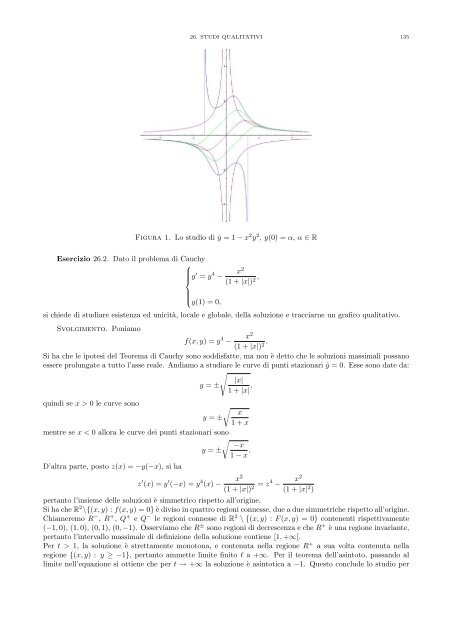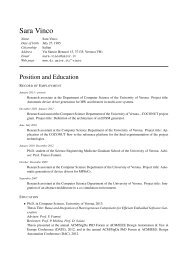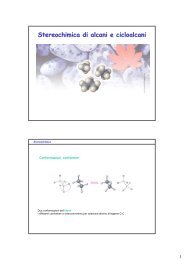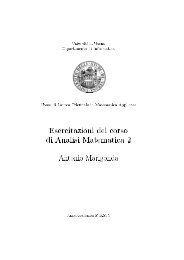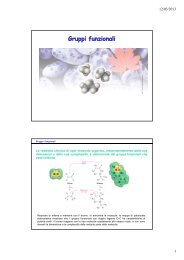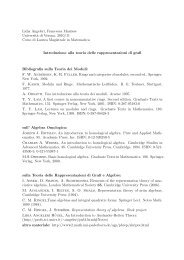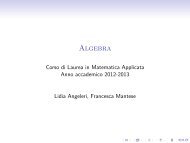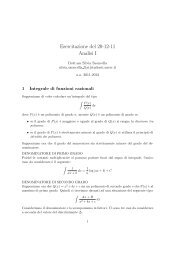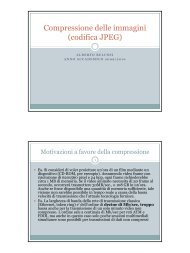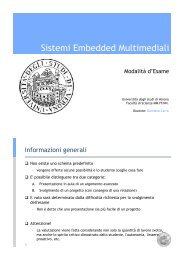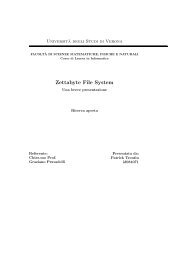Create successful ePaper yourself
Turn your PDF publications into a flip-book with our unique Google optimized e-Paper software.
Esercizio <strong>26</strong>.2. Dato il problema di Cauchy<br />
⎧<br />
⎪⎨<br />
<strong>26</strong>. STUDI QUALITATIVI 135<br />
Figura 1. Lo studio di ˙y = 1 − x 2 y 2 , y(0) = α, α ∈ R<br />
y ′ = y 4 −<br />
⎪⎩<br />
y(1) = 0,<br />
x2 ,<br />
(1 + |x|) 2<br />
si chiede di studiare esistenza ed unic<strong>it</strong>à, locale e globale, della soluzione e tracciarne un grafico qual<strong>it</strong>ativo.<br />
Svolgimento. Poniamo<br />
f(x, y) = y 4 − .<br />
(1 + |x|) 2<br />
Si ha che le ipotesi del Teorema di Cauchy sono soddisfatte, ma non è detto che le soluzioni massimali possano<br />
essere prolungate a tutto l’asse reale. Andiamo a studiare le curve di punti stazionari ˙y = 0. Esse sono date da:<br />
y = ±<br />
<br />
x 2<br />
|x|<br />
1 + |x| ,<br />
quindi se x > 0 le curve sono<br />
<br />
x<br />
y = ±<br />
1 + x<br />
mentre se x < 0 allora le curve dei punti stazionari sono<br />
<br />
−x<br />
y = ±<br />
1 − x .<br />
D’altra parte, posto z(x) = −y(−x), si ha<br />
z ′ (x) = y ′ (−x) = y 4 (x) −<br />
x2 (1 + |x|) 2 = z4 x<br />
−<br />
2<br />
(1 + |x| 2 )<br />
pertanto l’insieme delle soluzioni è simmetrico rispetto all’origine.<br />
Si ha che R 2 \{(x, y) : f(x, y) = 0} è diviso in quattro regioni connesse, due a due simmetriche rispetto all’origine.<br />
Chiameremo R − , R + , Q + e Q − le regioni connesse di R 2 \ {(x, y) : F (x, y) = 0} contenenti rispettivamente<br />
(−1, 0), (1, 0), (0, 1), (0, −1). Osserviamo che R ± sono regioni di decrescenza e che R + è una regione invariante,<br />
pertanto l’intervallo massimale di definizione della soluzione contiene [1, +∞[.<br />
Per t > 1, la soluzione è strettamente monotona, e contenuta nella regione R + a sua volta contenuta nella<br />
regione {(x, y) : y ≥ −1}, pertanto ammette lim<strong>it</strong>e fin<strong>it</strong>o ℓ a +∞. Per il teorema dell’asintoto, passando al<br />
lim<strong>it</strong>e nell’equazione si ottiene che per t → +∞ la soluzione è asintotica a −1. Questo conclude lo studio per


